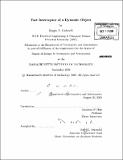| dc.contributor.advisor | Jonathan P. How. | en_US |
| dc.contributor.author | Cafarelli, Sergio A | en_US |
| dc.contributor.other | Massachusetts Institute of Technology. Dept. of Aeronautics and Astronautics. | en_US |
| dc.date.accessioned | 2010-04-28T17:08:12Z | |
| dc.date.available | 2010-04-28T17:08:12Z | |
| dc.date.copyright | 2009 | en_US |
| dc.date.issued | 2009 | en_US |
| dc.identifier.uri | http://hdl.handle.net/1721.1/54605 | |
| dc.description | Thesis (S.M.)--Massachusetts Institute of Technology, Dept. of Aeronautics and Astronautics, 2009. | en_US |
| dc.description | Cataloged from PDF version of thesis. | en_US |
| dc.description | Includes bibliographical references (p. 99-100). | en_US |
| dc.description.abstract | This thesis presents a path planning and control strategy that enables an unmanned non-holonomic vehicle to intercept a fast moving object. The path planning is performed under model uncertainty, with respect to the vehicle's maneuverability, as well as uncertainty in the estimation of the object's future trajectory and position. This problem involves the tracking of the dynamic object in a cluttered environment and the accurate estimation of its future position in the presence of noisy measurements. The ground vehicle (interceptor) is required to intercept the dynamic object at a predicted (catch) location in a finite amount of time. This time restriction presents quite a challenge given the inherent limitation in the vehicle's steering and maneuverability. The solution strategy is divided into three sub-problems: 1) prediction, 2) path planning and 3) control. The prediction of the parameters that describe the dynamic's object in space is accomplished via Kalman Filtering which, in conjunction with an impact predictor, provide the waypoints needed to construct a reference path that will place the interceptor on a collision course with the dynamic object (target.) A pure pursuit algorithm was used to steer the interceptor along a reference trajectory, which was designed to make the vehicle engage the dynamic object on a near tail-on aspect. In the endgame, the pure pursuit algorithm was modified to ensure arrival to the catch point while a position controller was added to ensure timely arrival to the predicted catch location. The problem statement was then augmented to include obstacle avoidance. | en_US |
| dc.description.abstract | (cont.) The dynamic object was required to navigate around fixed obstacles in order to catch the dynamic object. Results will show that the proposed strategy performed very well in the absence of obstacles and was well suited to handle the maneuverability constraints of the non-holonomic vehicle. Results also will show that, with minor modifications to the path planner, the interceptor successfully managed to avoid obstacles and catch the dynamic object although at a slightly lower success rate. The proposed solution was first demonstrated in simulation and then tested using MIT's RAVEN testbed. | en_US |
| dc.description.statementofresponsibility | by Sergio A. Cafarelli. | en_US |
| dc.format.extent | 100 p. | en_US |
| dc.language.iso | eng | en_US |
| dc.publisher | Massachusetts Institute of Technology | en_US |
| dc.rights | M.I.T. theses are protected by
copyright. They may be viewed from this source for any purpose, but
reproduction or distribution in any format is prohibited without written
permission. See provided URL for inquiries about permission. | en_US |
| dc.rights.uri | http://dspace.mit.edu/handle/1721.1/7582 | en_US |
| dc.subject | Aeronautics and Astronautics. | en_US |
| dc.title | Fast interceptor of a dynamic object | en_US |
| dc.type | Thesis | en_US |
| dc.description.degree | S.M. | en_US |
| dc.contributor.department | Massachusetts Institute of Technology. Department of Aeronautics and Astronautics | |
| dc.identifier.oclc | 599975056 | en_US |
